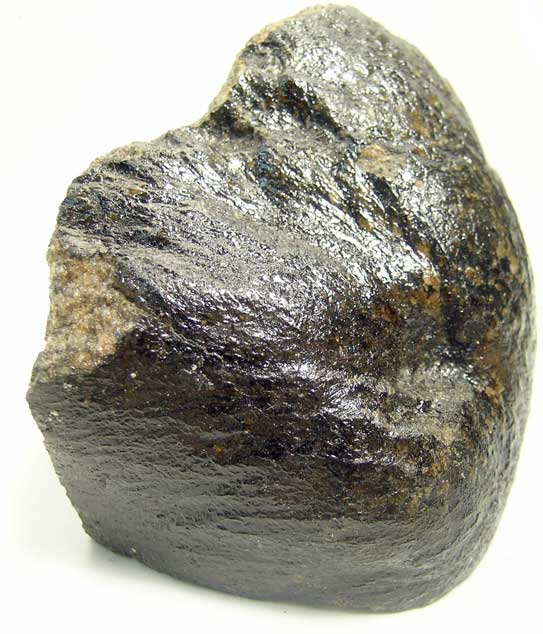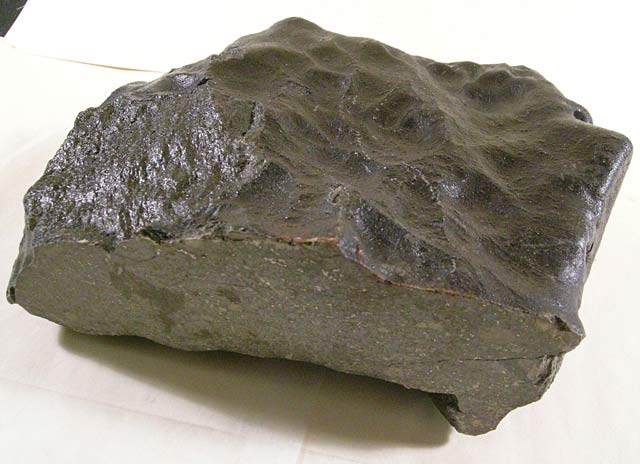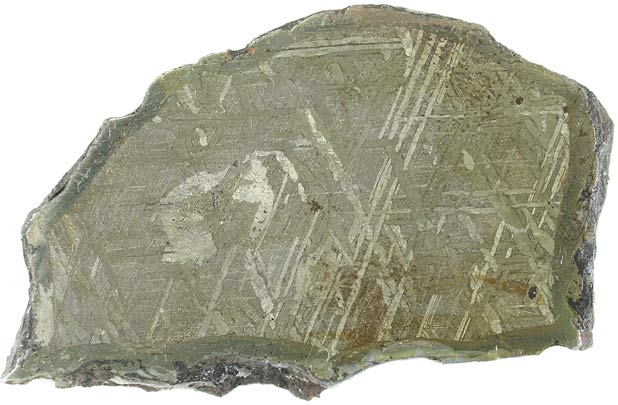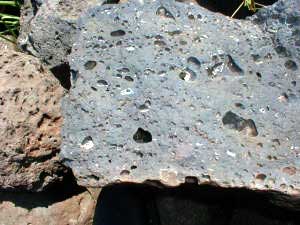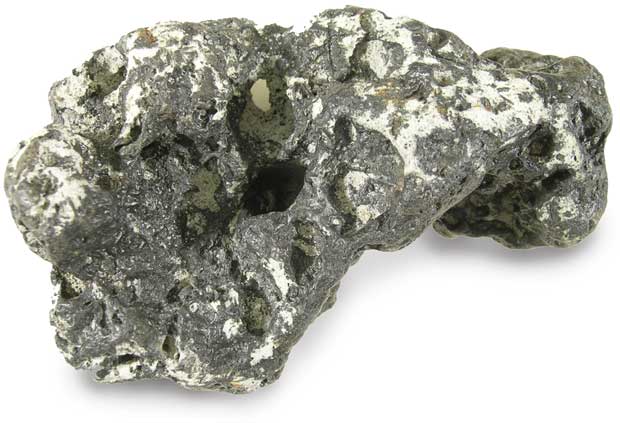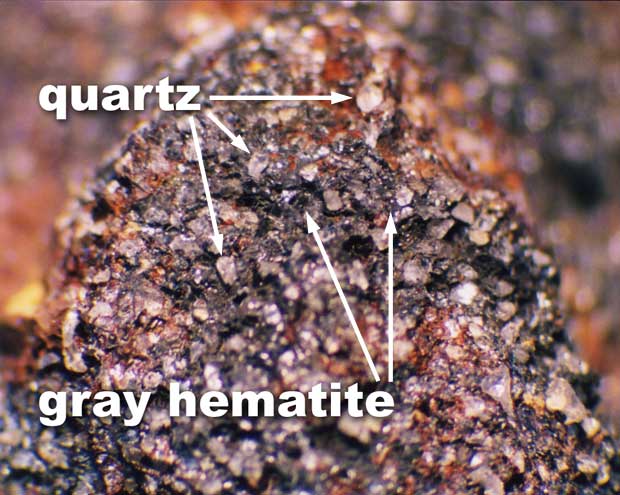1.What is a meteorite?
Meteorites are remnants of the early solar system, parts of small planetary masses, or even pieces of the Moon or Mars. Meteorites have given us priceless information about the formation of our solar system, our world and other worlds.
Return to Top2.Have meteorites been found in North Carolina?
The North Carolina Museum of Natural Sciences has samples of most of the meteorites that have landed in the state. Thirty have been seen falling or have been found later. The last one fell in the 1930s.
Return to Top3.I think I've found a meteorite; how can I tell if it is or not?
It is possible (although not likely) that you have found a meteorite. There are literally tons of natural space debris that fall to Earth or burn up in the atmosphere each year. The rest of this page will help you determine if you have found a meteorite.
Return to TopFlight Markings
A meteorite may fall "nose down" through the atmosphere or it may tumble. Meteorites that do not tumble can assume aerodynamic, streamlined shapes as material is removed by atmospheric friction. In the photo to the right, lines stream back from the nose of the meteorite. Some meteorites even show trails of melted droplets that start at one point and fan out over the surface of the meteorite.
Return to TopFusion Crust
One of the most distinctive features of a meteorite is the fusion crust (Right). It forms as the meteorite encounters atmospheric friction as it plunges to Earth. A very thin rind forms as the outside of the meteorite melts. This happens quickly enough that the interior of the meteorite does not heat up. A similar crust sometimes forms on terrestrial rocks due to weathering, but breaking or cutting your find should show the difference.
Return to TopRegmaglypts
Some meteorites develop shallow depressions on the outside that look like the flat thumbprints you can make in clay (Right). These markings, called regmaglypts, are distinctive for meteorites. These also form through abrasion with the atmosphere.
Return to TopWidmanstätten texture
Nickel-iron meteorites represent the cores of small planets that formed early in our solar system’s history.As the solid metal cools below 600°C, the metal organizes itself into high-nickel and low-nickel domains, showing an octahedral pattern (Right). This is a process known as exsolution, similar to the unmixing of oil and water. When a meteorite is cut, polished and etched with acid, the Widmanstätten texture becomes visible. This is a feature not seen in terrestrial rocks.
Return to TopMagnetism
Many common meteorites are strongly magnetic — a refrigerator magnet will react to it. However, other terrestrial materials are also magnetic, like the mineral magnetite and some metal furnace slags. Therefore, this test is not definitive for meteorites and should be considered as only one of many clues.
Return to TopMetallic appearance
As a general rule, metals found on Earth are either man-made or a meteorite. A piece of metal without holes or bubbles in it may be a meteorite. There are some minerals, though, that have a metallic luster, such as hematite. Rub your find on a piece of unfinished ceramic tile (it can be bought cheaply at many hardware stores). If the streak is red, the mineral is hematite. Another clue is whether or not you can break a piece off the specimen. If it is a meteorite, then it is similar to naturally-occurring steel — it will be very hard to break.
Return to TopBasaltic lava
Lava from the western United States often resembles meteorites because of its brown to black color. However, a rock from a lava flow often has vesicles — the little round bubbles where gas is trapped in the cooling rock (Right). These rocks are commonly used in gas grills as "lava rocks." If your find has any holes or bubbles in it then it is not a meteorite. Extraterrestrial rocks contain very little water or carbon dioxide.
Return to TopIron slag or clinker
The most common imposter for a meteorite is metal slag from a furnace or blacksmith shop. Early in North Carolina’s history, many small iron foundries or blacksmith shops operated wherever iron ores could be found. There were many of these small, undocumented operations in the state, and often a bit of slag is the only clue as to where they once stood. Slag is a byproduct of reducing ore to metal. Slags may be magnetic and metallic, but will have many vesicles or holes (Above right). Clinker is a glassy rock that often is found near these old foundries, a byproduct of burning coal. If you found your meteorite near the railroad tracks, it’s probably clinker. The definitive test is to look for quartz, a clear or white mineral that will scratch a knife blade. Meteorites do not contain quartz.
Return to TopPhosphate nodules
If you found your meteorite at the beach, it is probably a piece of phosphate. During large storms, some material is ripped off of the sea floor and thrown onto the beach. These will usually be dark colored and rounded (Right). If you chip off a piece it will be the same color inside as out — that is, it won’t have a fusion crust — and a knife will scratch it easily. Again, if it has holes in it, it is not a meteorite.
Return to TopHematite-cemented sandstone
Hematite is a mineral that can have a metallic appearance, but it is not magnetic. It will have a red streak (see above under Metallic Appearance). Hematite is found in many places in North Carolina, often in a red earthy form or in a metallic flower-like form. In the western Coastal Plain near the Fall Line, a hematite-cemented sandstone is common and often called "Indian paintpots." The sandstone will have white quartz grains visible under magnification. These rocks are often knobby and orange colored from the weathering of hematite to limonite.
Return to TopDiabase or other volcanic rock
In many places in North Carolina there are diabase dikes and high-iron volcanic rocks. These cool quickly enough that crystals may only be visible with magnification. They usually will have a reddish weathering rind that should not be mistaken for a fusion crust. Weathering rinds usually fade gradually from the outside to the inside of the rock, whereas fusion crusts are sharp and about 1mm thick (Above). If you break a piece off with a hammer, it will not have metal inside, although it may attract a magnet to some degree.
If you are still uncertain about your possible meteorite, you can visit the Museum’s Naturalist Center (919.733.7450, ext. 626). A selection of materials that are commonly mistaken for meteorites is available for comparison. Portions of the Farmville meteorite (third floor) and the Uwharrie meteorite (first floor) are on display in the Museum as well.
Return to Top

